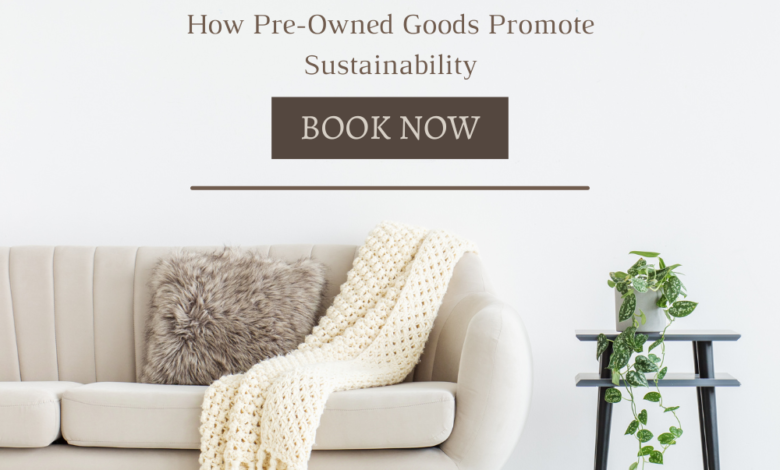The Green Home Movement: How Pre-Owned Goods Promote Sustainability

In an era where climate change and environmental degradation dominate global conversations, the importance of sustainable living cannot be overstated. The Green Home Movement, which emphasizes reducing waste and conserving resources, has become a pivotal aspect of this conversation. One of the most effective and accessible ways to embrace this movement is through the adoption of pre-owned goods. In this article, we will explore how pre-owned items play a crucial role in promoting sustainability and how they contribute to a greener, more sustainable future.
Understanding the Green Home Movement
The Green Home Movement encourages individuals to adopt environmentally friendly practices in their daily lives. This movement encompasses a wide range of actions, from reducing energy consumption to choosing eco-friendly materials for home construction and decor. However, one of the most significant and often overlooked aspects of this movement is the promotion of second-hand shopping.
The Environmental Impact of the Fashion Industry
The fashion industry is one of the most resource-intensive and polluting industries globally. It’s responsible for a significant portion of global carbon emissions, water pollution, and waste. According to Earth.org, approximately 11.3 million tons of textile waste end up in landfills in the U.S. each year. Additionally, the number of times a garment is worn has decreased by nearly 40% since 2007. This throwaway culture exacerbates the environmental footprint of fashion, making it unsustainable in the long run.
How Pre-Owned Goods Reduce Textile Waste
One of the most effective ways to combat textile waste is by extending the life of existing clothing. Pre-owned goods, particularly clothing, play a crucial role in this regard. By purchasing second-hand items, consumers give clothing a second life, diverting it from landfills and reducing the need for new production. This practice not only minimizes waste but also decreases the demand for the resources required to produce new garments.
Lowering the Carbon Footprint with Pre-Owned Goods
The production of new goods, including clothing, furniture, and electronics, involves multiple stages that contribute to greenhouse gas emissions. These stages include the extraction of raw materials, manufacturing, transportation, and distribution. By choosing pre-owned goods, consumers can significantly reduce their carbon footprint. Second-hand shopping requires far fewer resources and energy, making it a more sustainable option.
For example, if every consumer bought just one second-hand garment instead of a new one this year, it would lower CO2 emissions by more than 2 billion pounds. This reduction is equivalent to taking 76 million cars off the road for a day. Additionally, it would save approximately 23 billion gallons of water and 4 billion kilowatt-hours of energy, according to a report by ThredUp.
Conserving Natural Resources
The creation of new products, particularly in the fashion and furniture industries, consumes vast amounts of natural resources such as water, energy, and raw materials. For instance, producing a single cotton t-shirt can require as much as 712 gallons of water. When consumers opt for pre-owned items, they help conserve these precious resources by reducing the demand for new production. This conservation effort is critical as many of the resources used in manufacturing are non-renewable, meaning they cannot be replaced once depleted.
The Role of Ethical Consumption in Sustainability
Ethical consumption involves making purchasing decisions that consider the environmental and social impacts of products. By choosing pre-owned goods, consumers are not only reducing their environmental footprint but also promoting ethical consumption. Second-hand shopping often bypasses the unethical labor practices associated with fast fashion, where workers in developing countries are often paid meager wages and work in poor conditions. By valuing and reusing existing items, consumers can support more sustainable and ethical practices.
Encouraging Circular Fashion
Circular fashion is a concept that emphasizes the continuous use and reuse of clothing, as opposed to the traditional linear model of produce-use-dispose. Pre-owned goods are a prime example of circular fashion in action. When consumers buy and sell second-hand clothing, they contribute to a circular economy where products are kept in use for as long as possible. This model not only reduces waste but also encourages a more sustainable approach to fashion consumption.
The Economic and Social Benefits of Pre-Owned Goods
Beyond environmental sustainability, pre-owned goods offer significant economic and social benefits. Many second-hand shops are small, local businesses that contribute to the vibrancy of communities. By supporting these stores, consumers help sustain local economies and promote sustainable retail practices. Additionally, second-hand shopping often provides access to unique, high-quality items at a fraction of the cost of new products, making it an economically viable option for many people.
Addressing the Challenges of Second-Hand Shopping
While second-hand shopping offers numerous benefits, it is not without its challenges. One of the primary concerns is the quality of pre-owned items. Not all used products are in good condition, and some may require repair or refurbishment. However, businesses like ReCircled are addressing this issue by repurposing used textiles and creating new products from them, such as yarns, composites for building materials, and home goods. This approach not only enhances the value of secondhand items but also contributes to the overall goal of reducing waste and promoting sustainability.
Practical Tips for Embracing Second-Hand Shopping
For those new to second-hand shopping, here are some practical tips to get started:
- Start Local: Visit local thrift stores, consignment shops, and garage sales. These places often have a wide range of items, from clothing to furniture, at affordable prices.
- Use Online Platforms: Websites like eBay, Poshmark, and Craigslist offer a vast selection of second-hand goods. These platforms make it easy to search for specific items from the comfort of your home.
- Be Patient: Finding the perfect pre-owned item may take time, but the environmental and financial rewards are worth the effort. Keep an open mind and enjoy the process of discovering unique treasures.
- Check Quality: Always inspect items carefully before purchasing. Look for any signs of wear and tear, and be prepared to make minor repairs if necessary.
- Think Long-Term: Consider the longevity of the items you purchase. Choose high-quality, durable goods that will serve you well for years to come.
Conclusion: A Greener Future Through Pre-Owned Goods
The Green Home Movement is more than just a trend; it’s a necessary shift toward more sustainable living practices. By embracing pre-owned goods, we can significantly reduce our environmental impact, conserve valuable resources, and promote ethical consumption. As more consumers and brands recognize the value of second-hand shopping, we can collectively work toward a future where sustainability is at the forefront of our choices.
Choosing pre-owned goods is not just about making eco-friendly decisions; it’s about being part of a broader movement that prioritizes the health of our planet and the well-being of future generations. So, the next time you’re in the market for clothing, furniture, or any other item, consider exploring the world of second-hand shopping. Together, we can make a difference and contribute to a more sustainable, greener future.
Meta Description:



